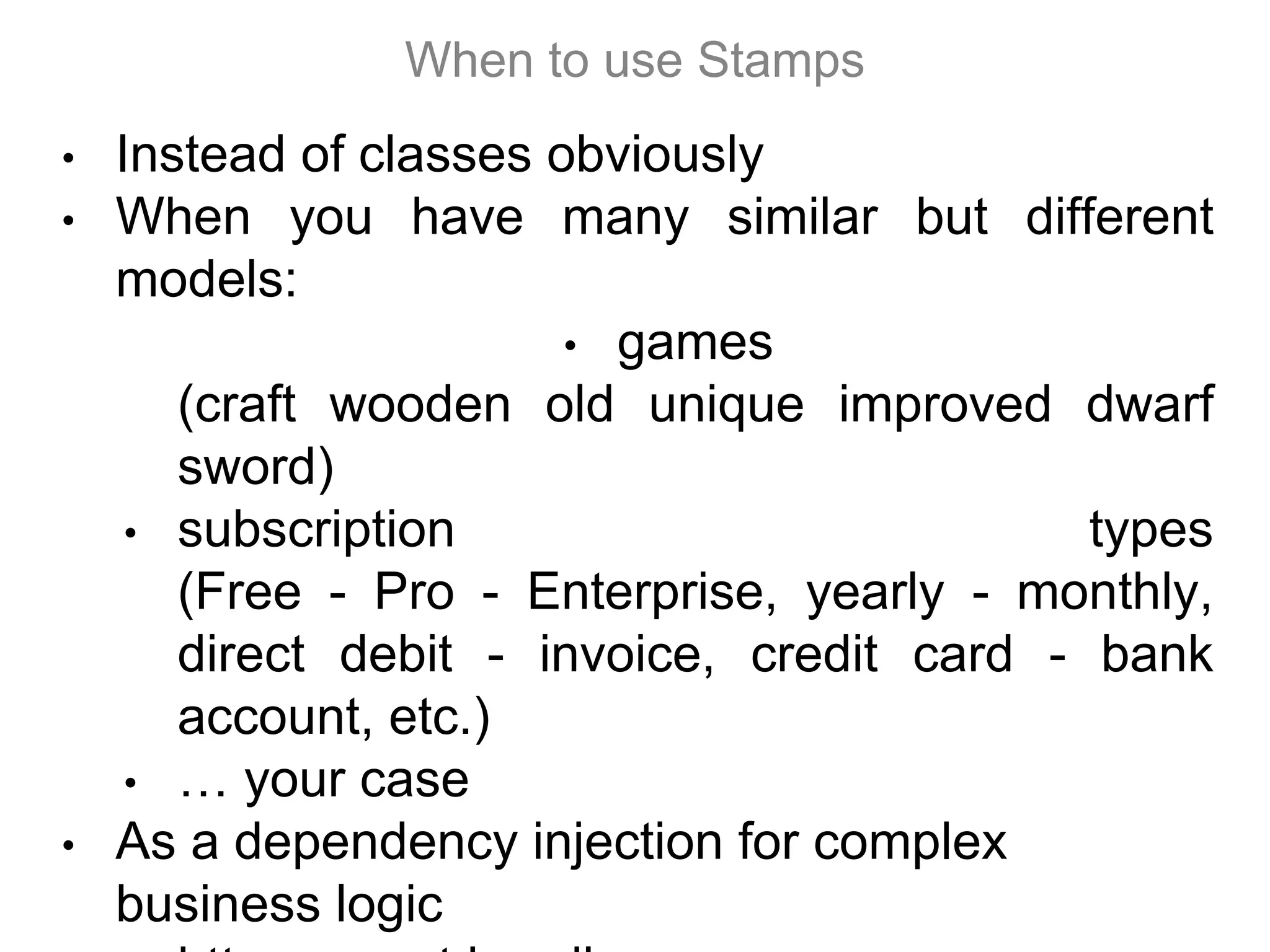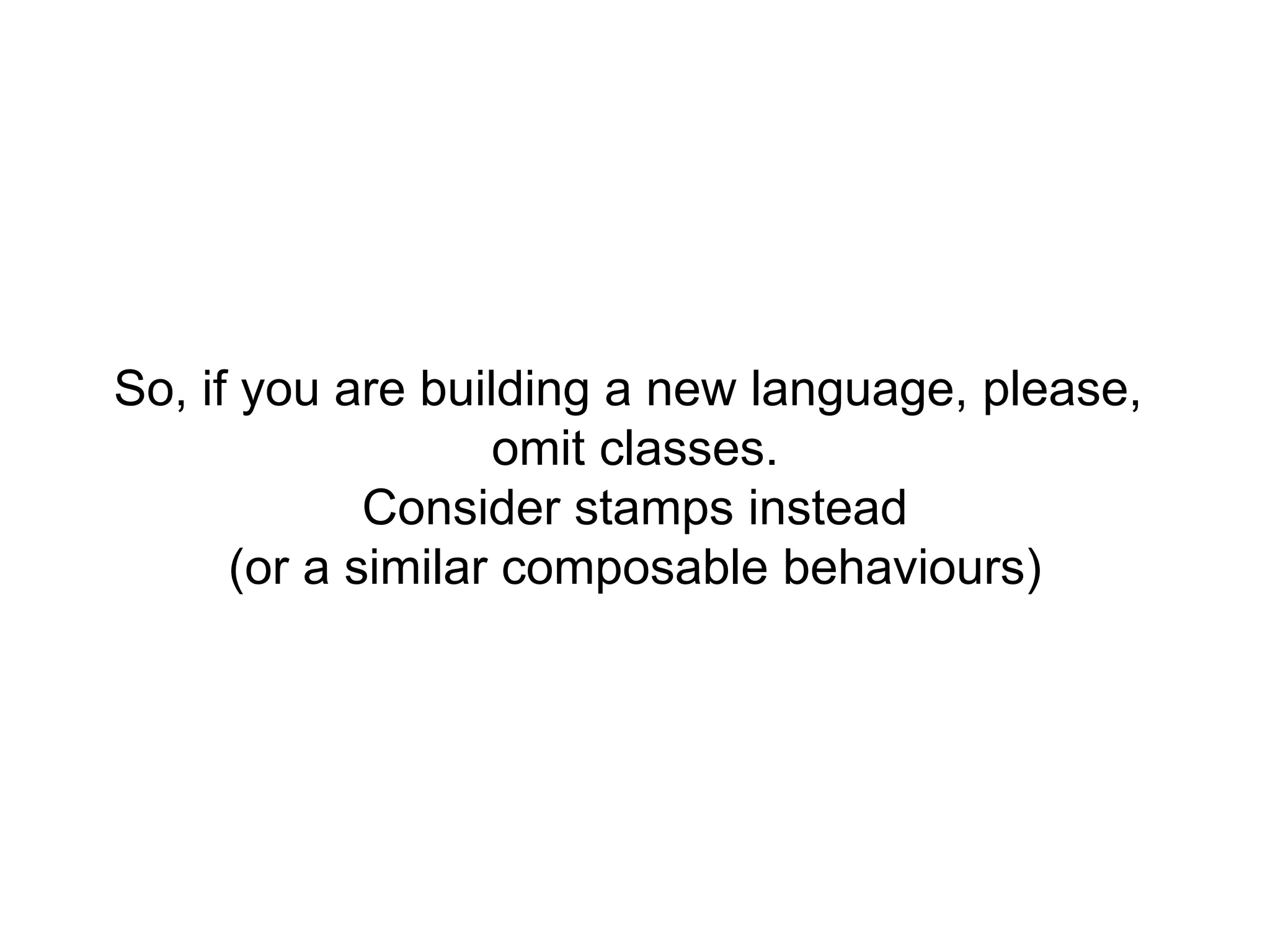The document discusses an approach called "stamps" for composing object behaviors in a declarative way, as an alternative to class inheritance. Stamps are like classes/factories but specify behaviors through composable metadata rather than inheritance. A stamp implementation is shown that allows defining initializers, methods, properties, and static properties and composing them to create new stamps. The stamps approach is compared to configuring classes through annotations and dependency injection in Java.


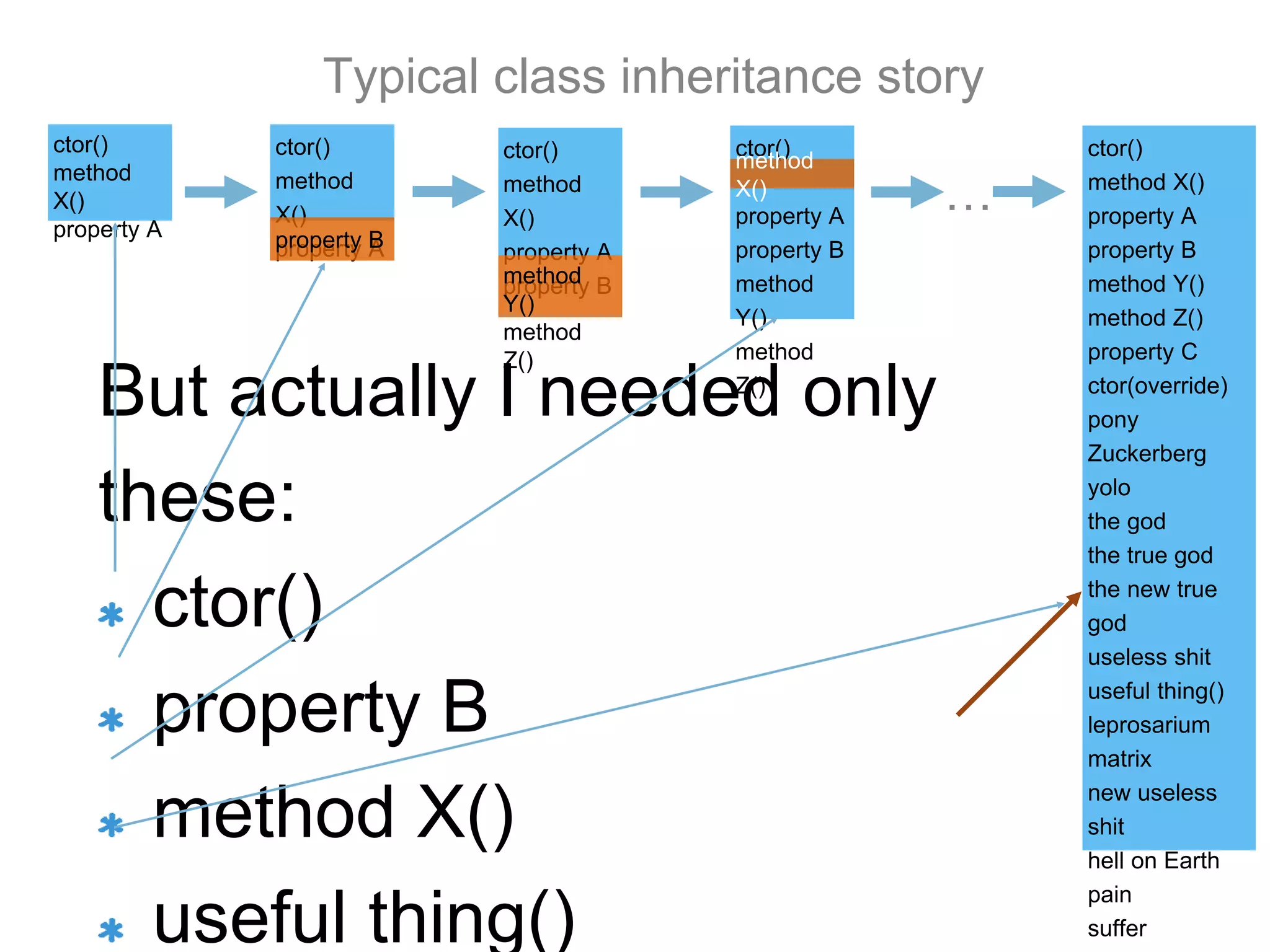
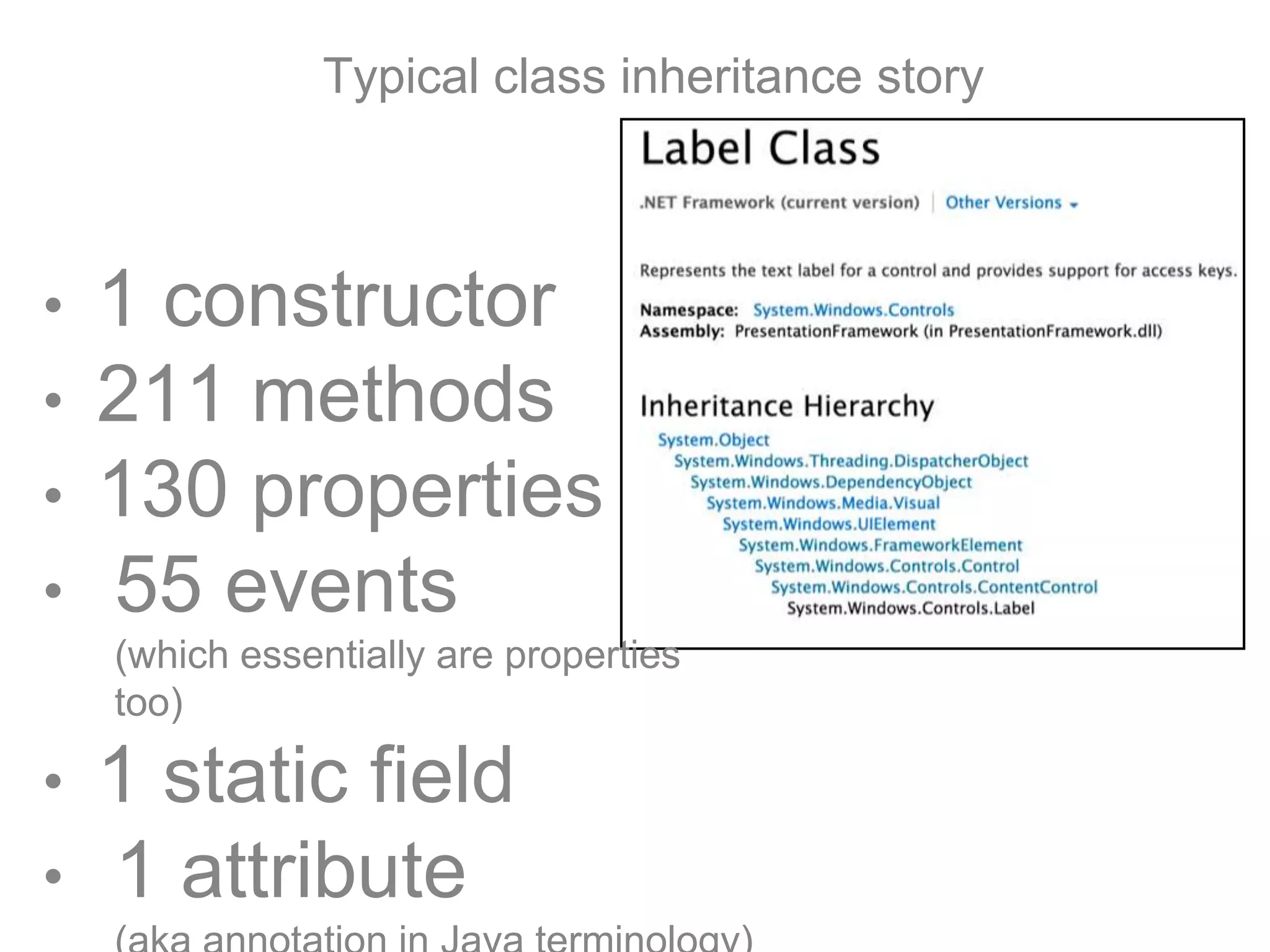
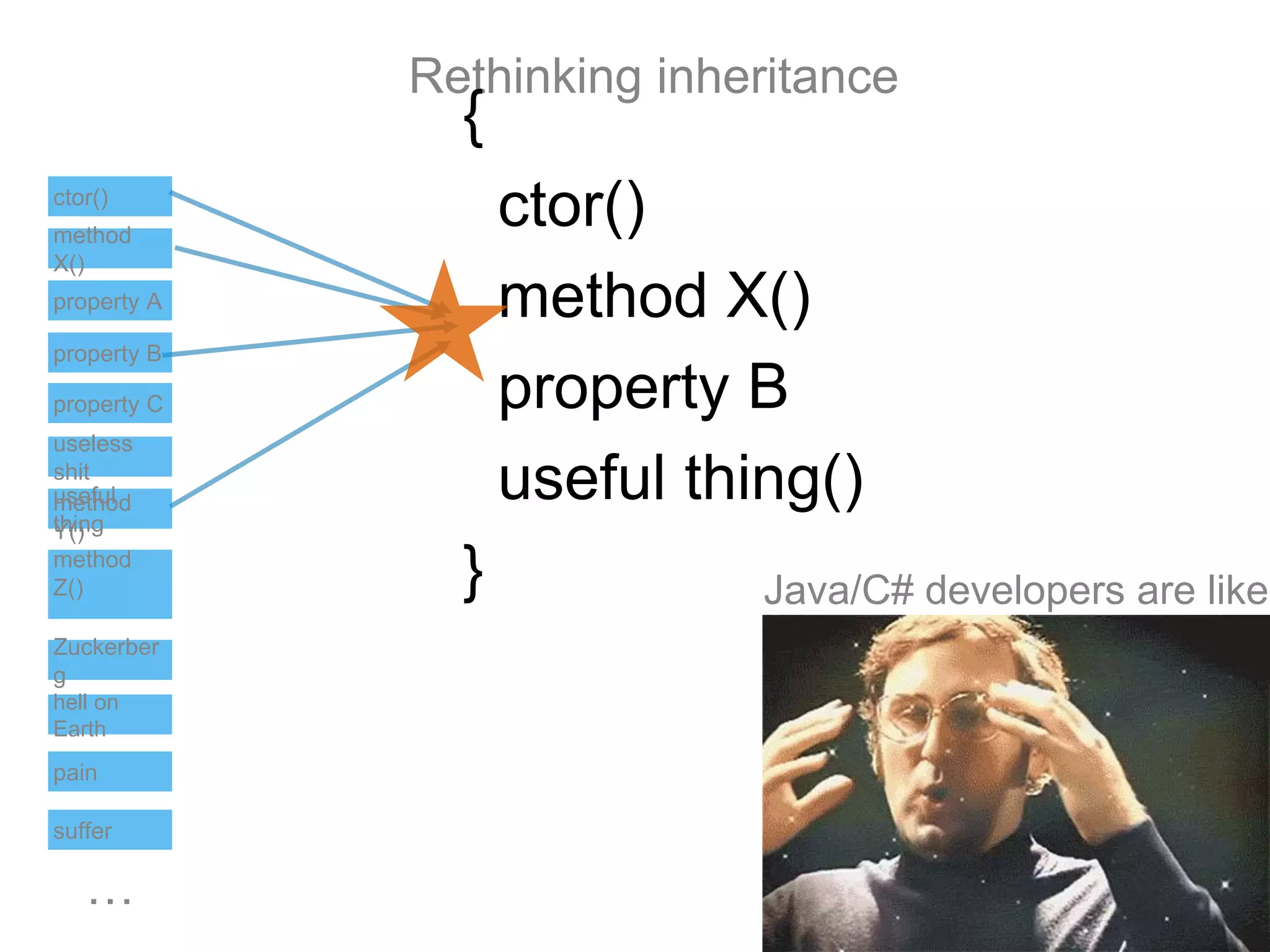

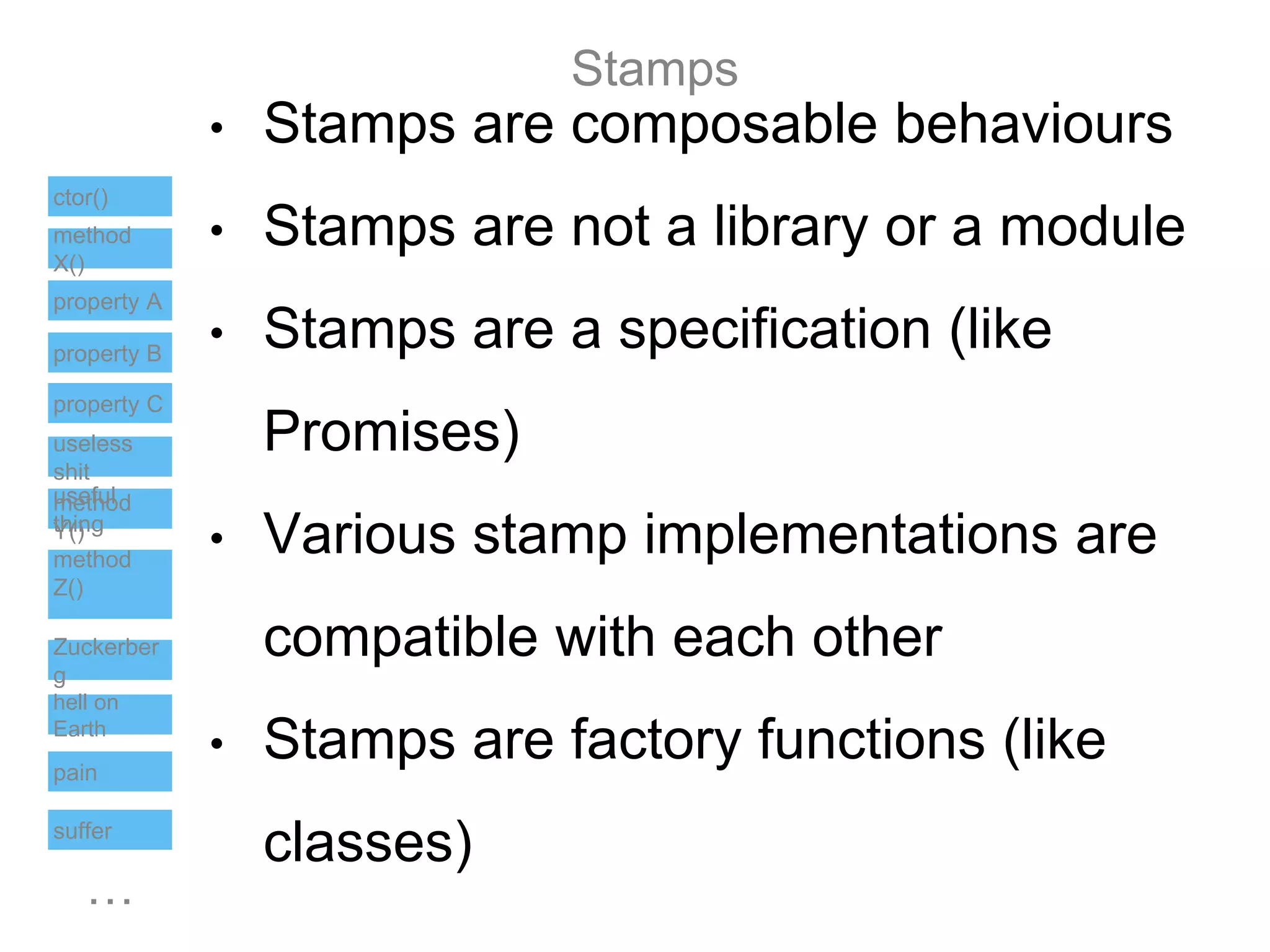
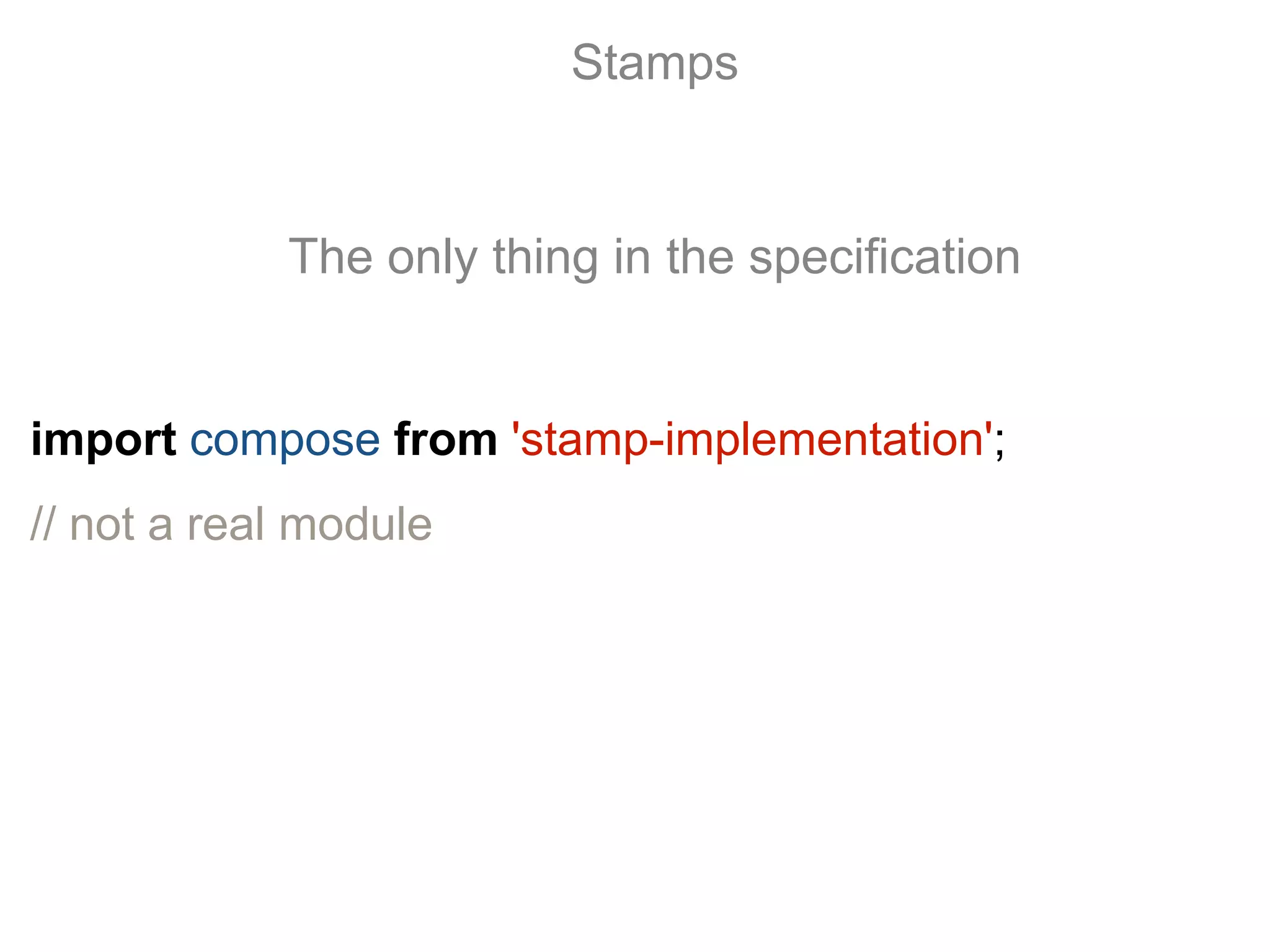
![const Ctor = compose({
initializers: [function (...args) {
console.log('Hello Node Ninjas')
}]
});
Ctor(...args); // “Hello Node Ninjas”
Stamps
Constructor aka initializer](https://image.slidesharecdn.com/nodeninjaspreso-160707131938/75/Stamps-a-better-way-to-object-composition-9-2048.jpg)
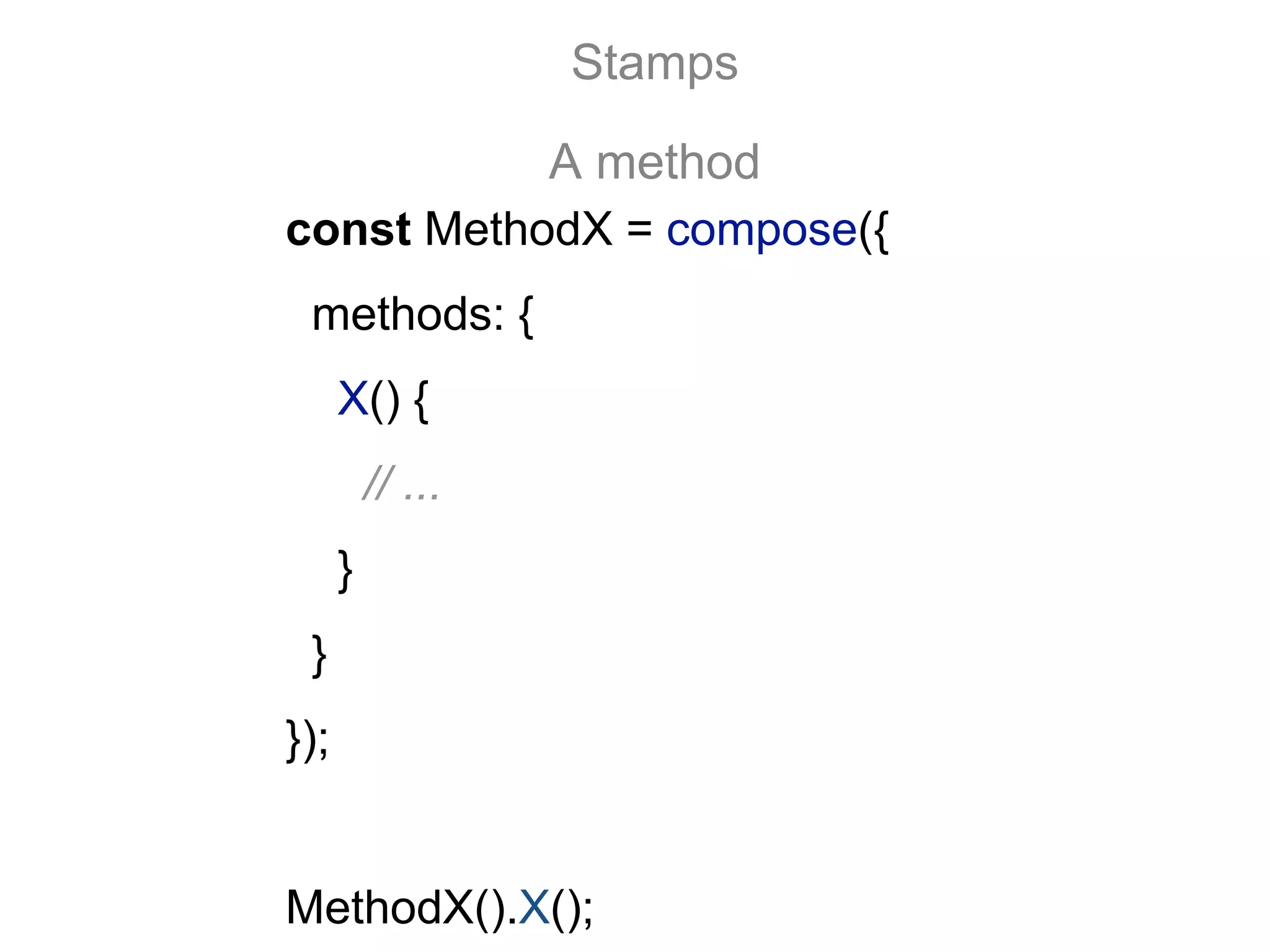
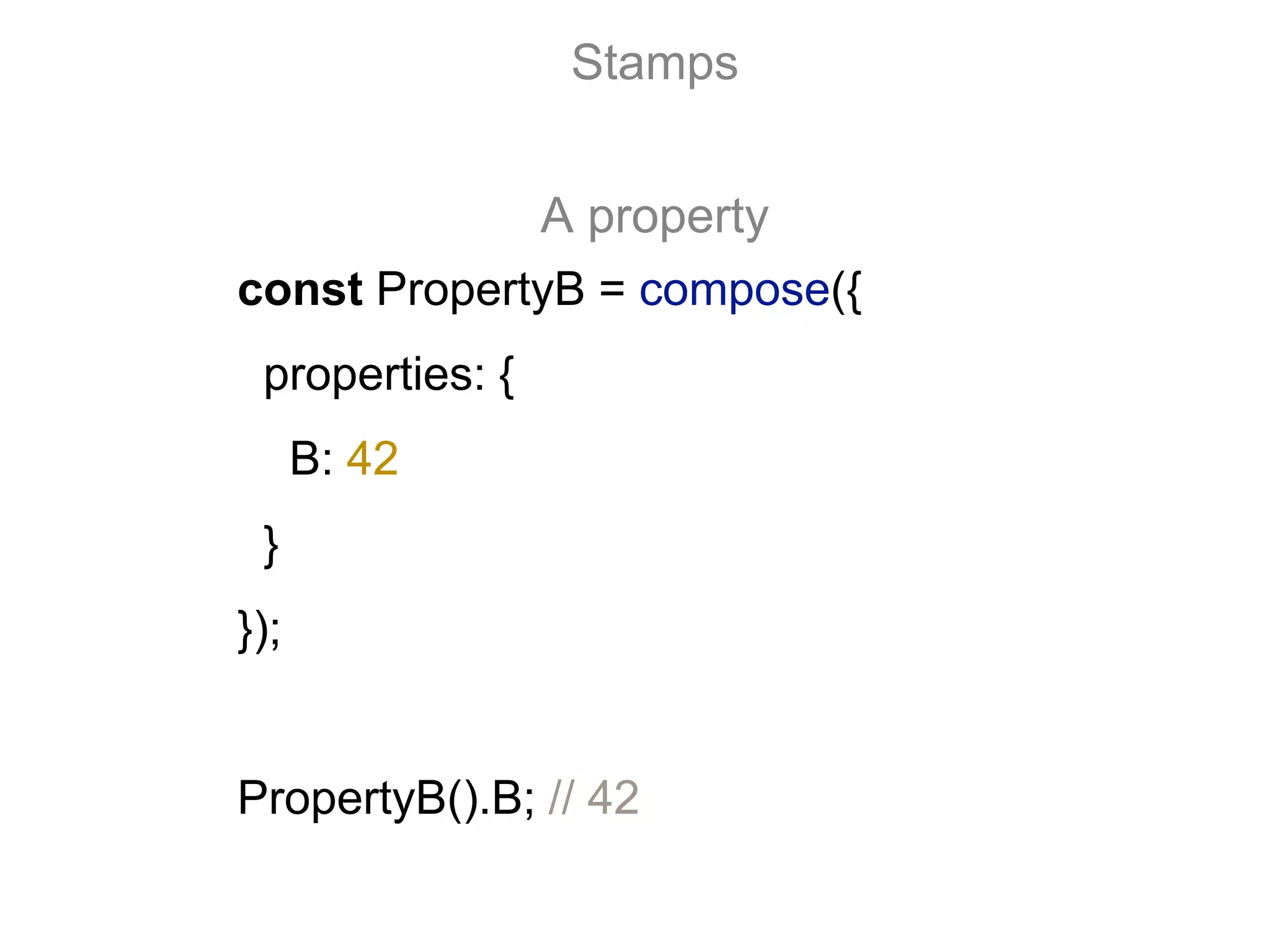
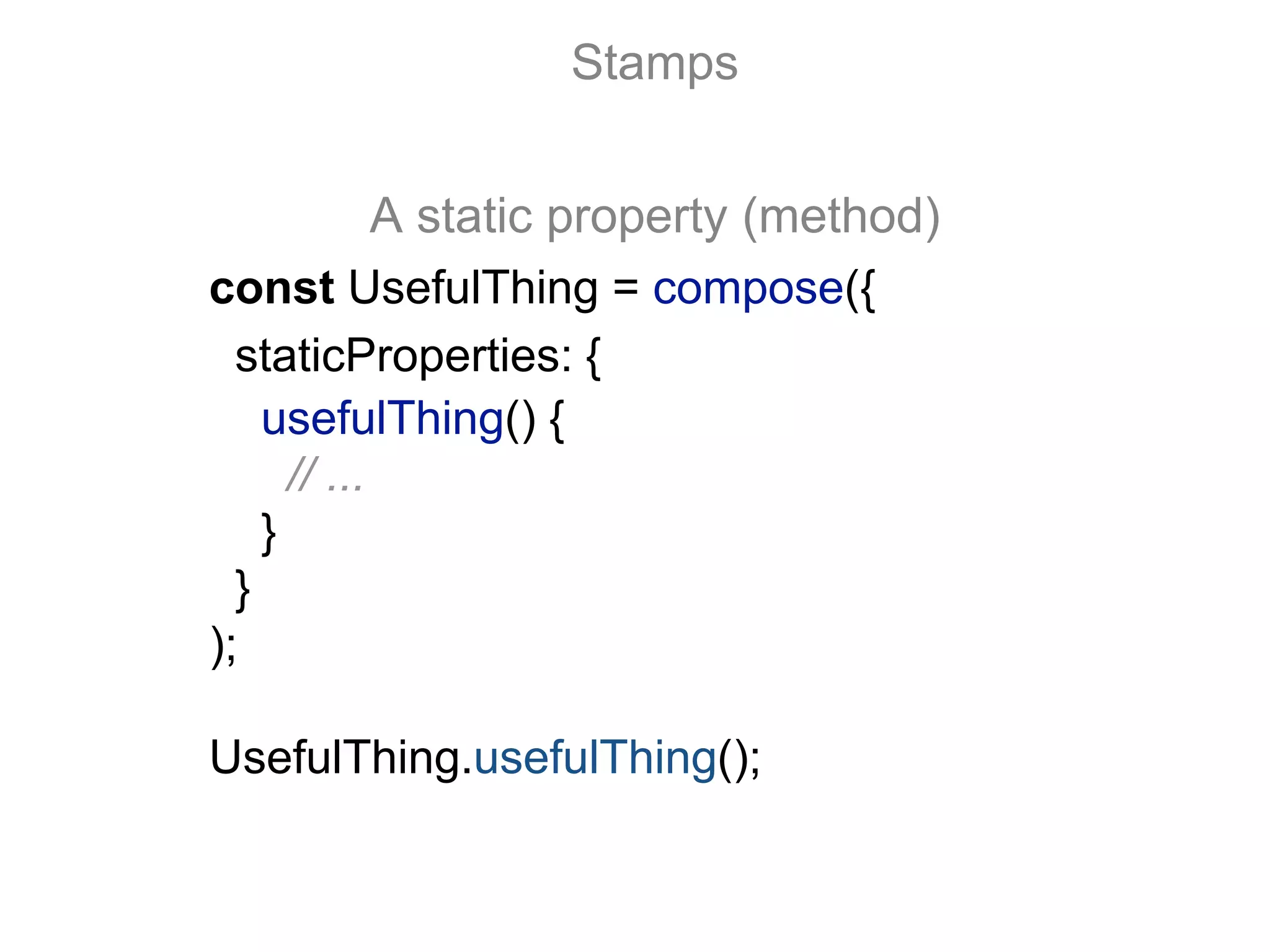
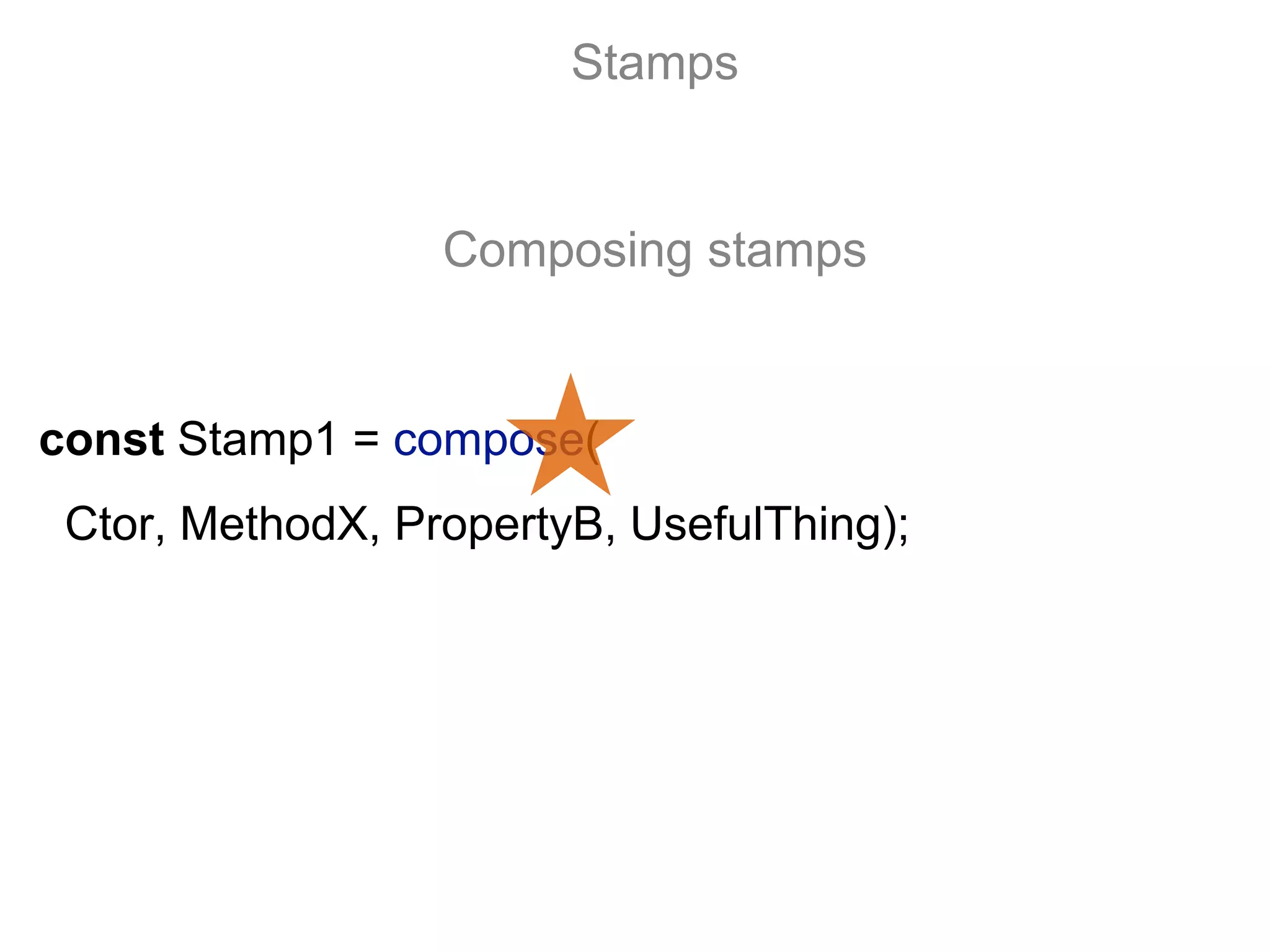
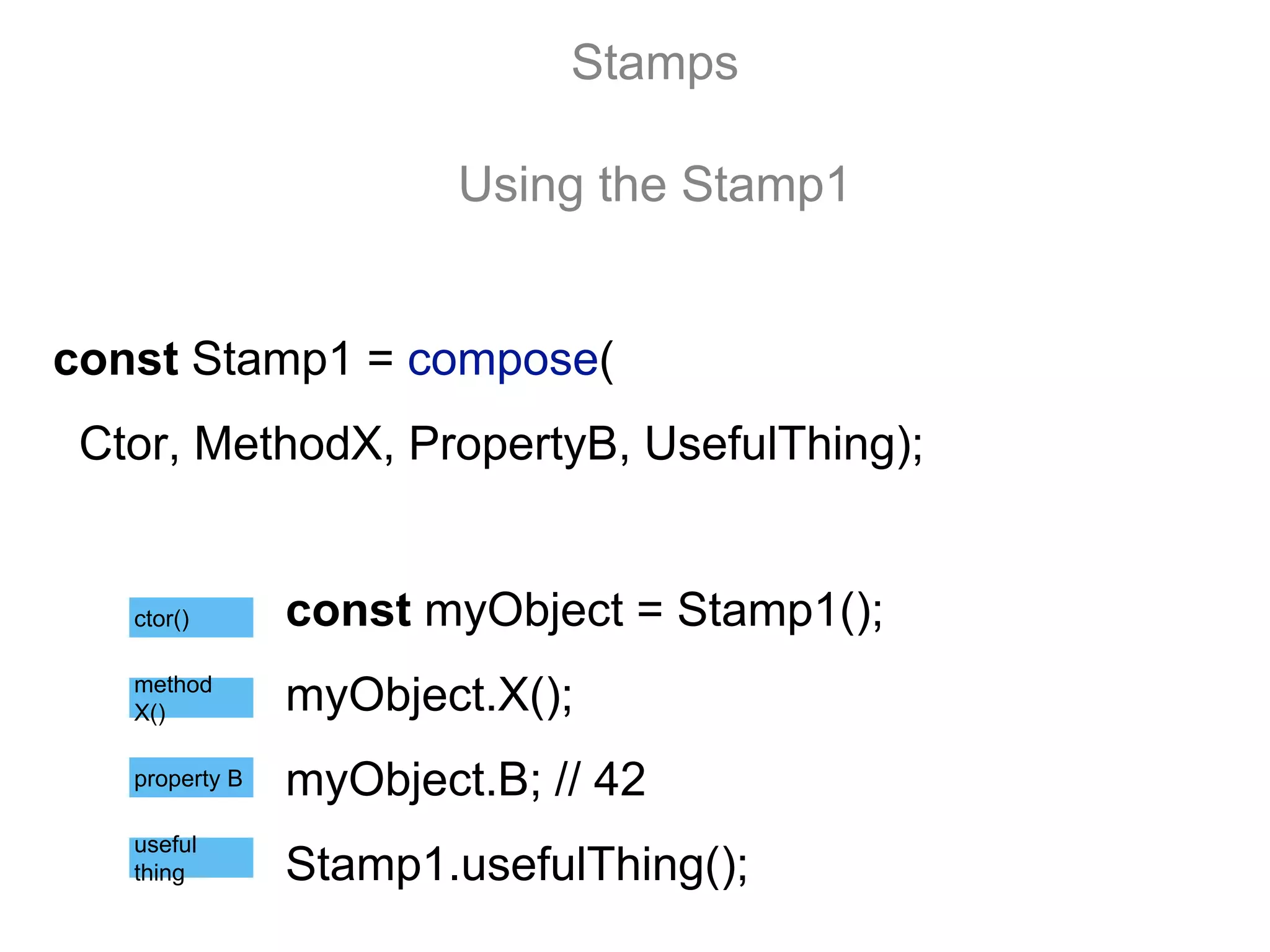
![import compose from 'stamp-implementation';
const Ctor = compose({
initializers: [ function () { /* … */ } ]
});
const MethodX = compose({
methods: { X() { /* … */ } }
});
const PropertyB = compose({
properties: { B: 42 }
});
const UsefulThing = compose({
staticProperties: { usefulThing() { /* … */ } }
});
const Stamp1 = compose(Ctor, MethodX, PropertyB, UsefulThing);
const myObject = Stamp1();
myObject.X();
myObject.B; // 42
Stamp1.usefulThing();
Stamps
ctor()
method
X()
property B
useful
thing](https://image.slidesharecdn.com/nodeninjaspreso-160707131938/75/Stamps-a-better-way-to-object-composition-15-2048.jpg)
![const Stamp1 = compose({
initializers: [() => {
// ...
}],
methods: {
X() {
// ...
}
},
properties: {
B: 42
},
staticProperties: {
usefulThing() {
// ...
}
}
});
const myObject = Stamp1();
myObject.X();
myObject.B; // 42
Stamp1.usefulThing();
Same but as a single stamp](https://image.slidesharecdn.com/nodeninjaspreso-160707131938/75/Stamps-a-better-way-to-object-composition-16-2048.jpg)
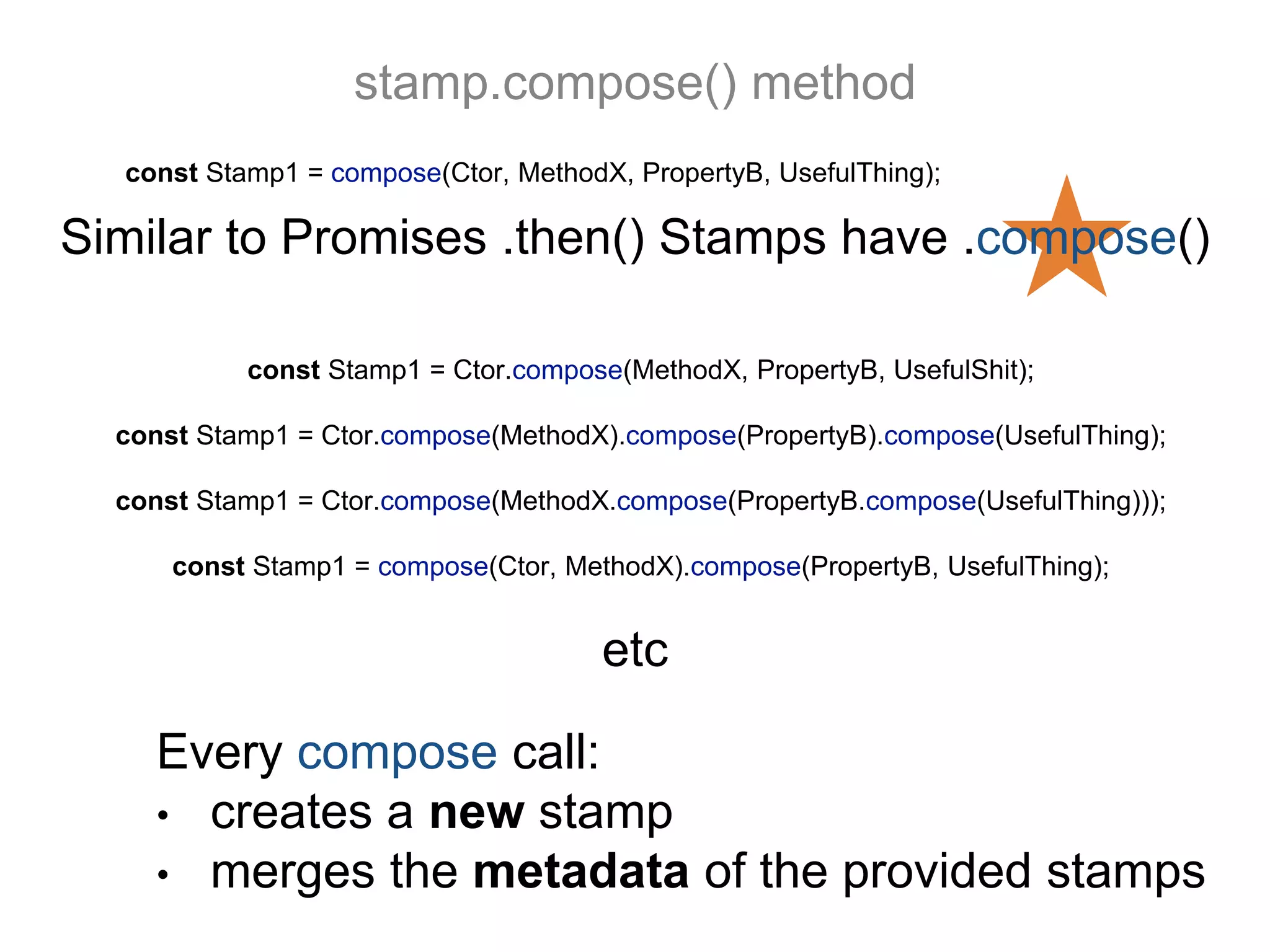
![Collected Stamp1 metadata
const Stamp1 = compose(Ctor, MethodX, PropertyB, UsefulThing);
console.log(Stamp1.compose);
{ [Function]
initializers: [ [Function] ],
methods: { X: [Function: X] },
properties: { B: 42 },
staticProperties: { usefulThing: [Function: usefulThing] } }
Stamp1.compose has:
property “initializers”
property “methods”
property “properties”
property “staticProperties”
ctor()
method
X()
property B
useful
thing](https://image.slidesharecdn.com/nodeninjaspreso-160707131938/75/Stamps-a-better-way-to-object-composition-18-2048.jpg)
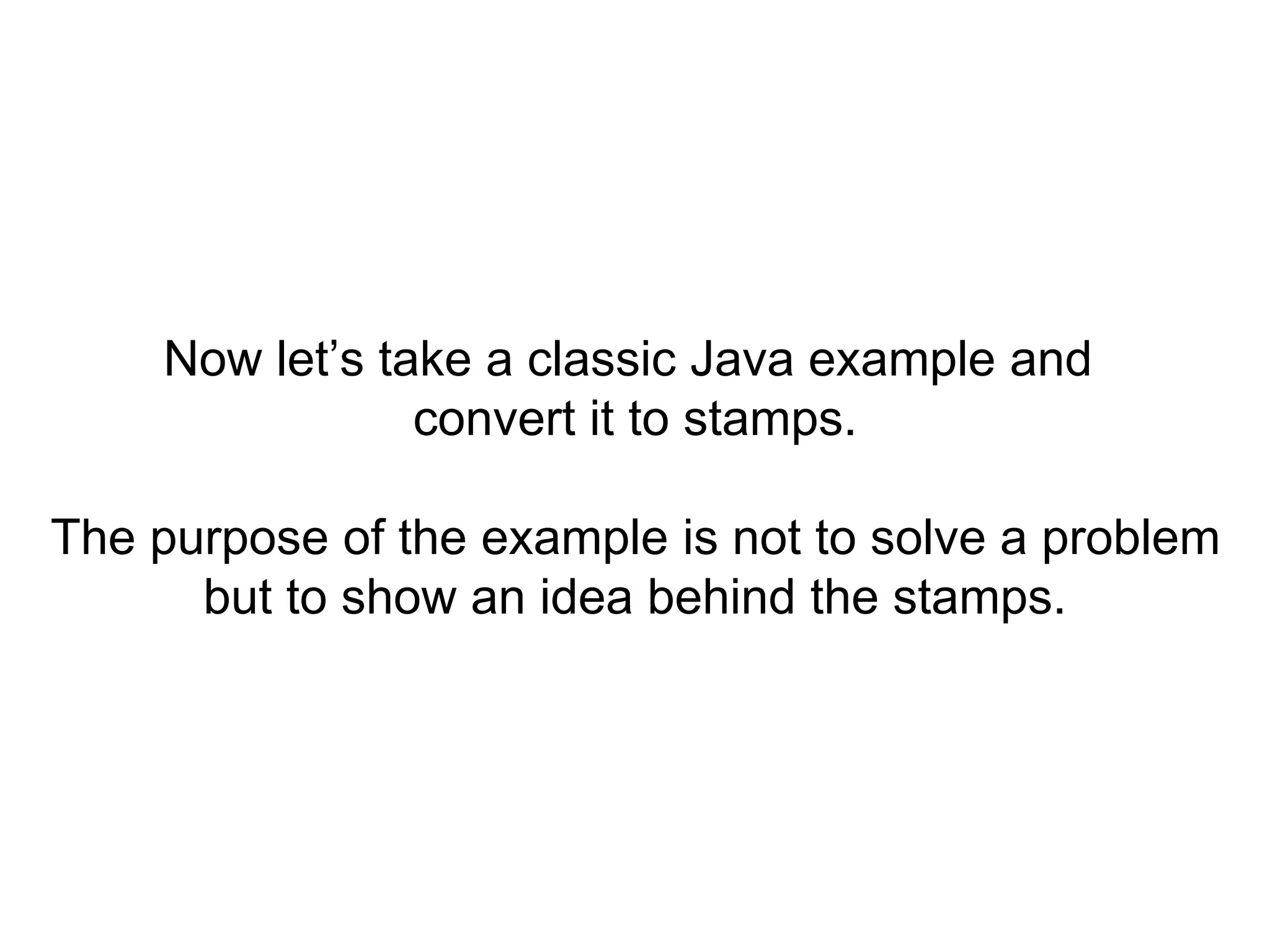
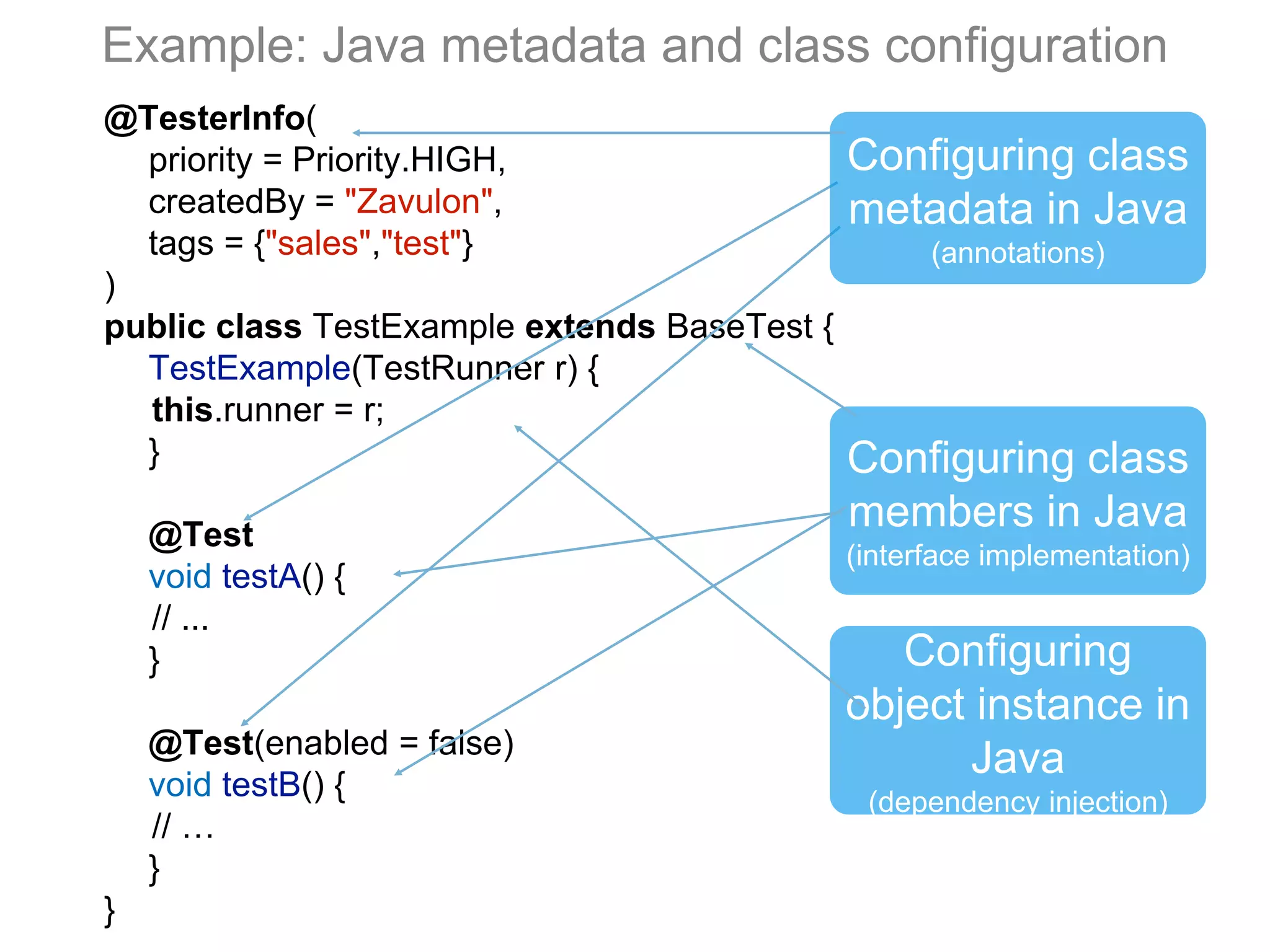
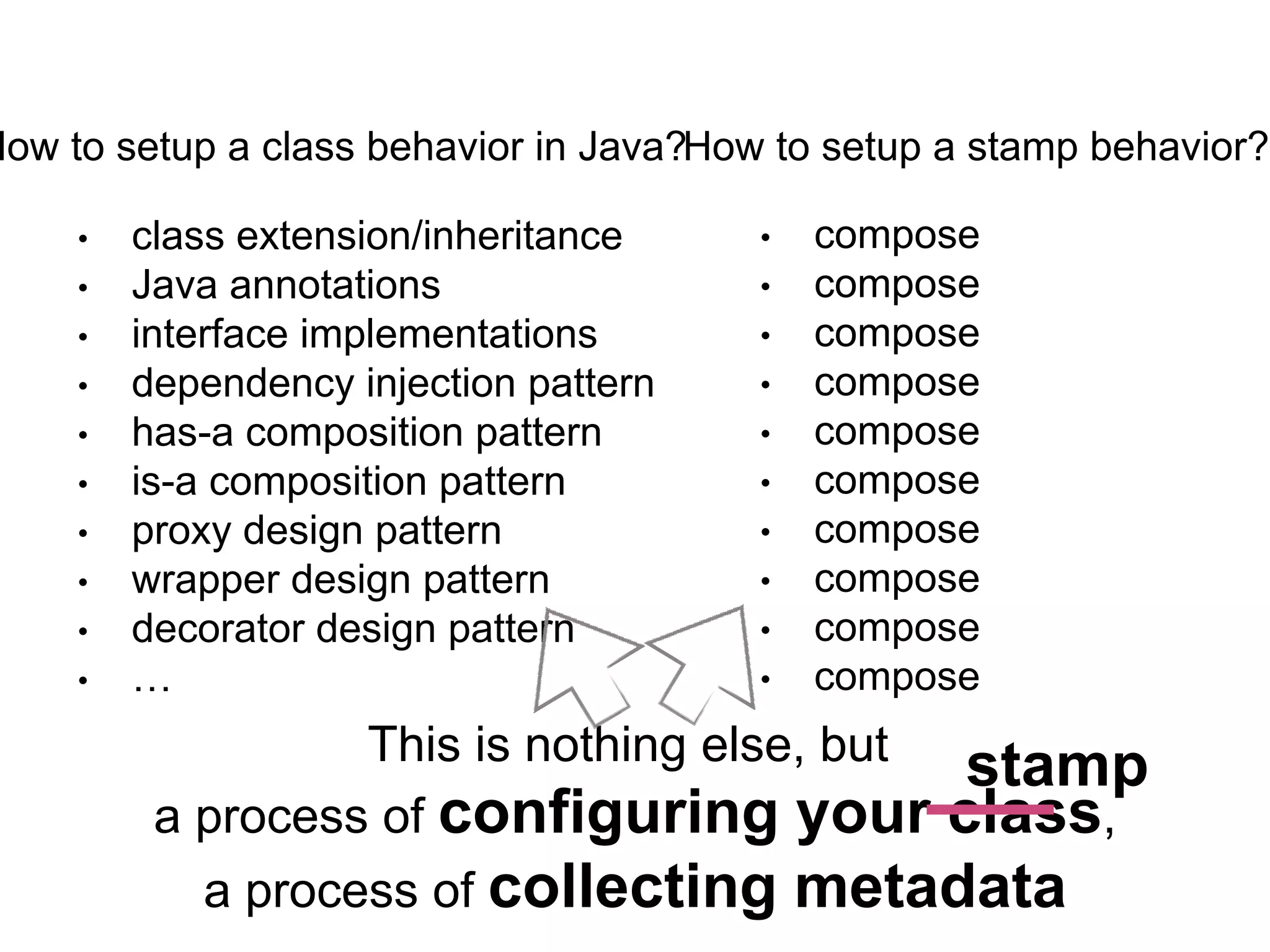

![const BaseTest = compose({
staticProperties: {
suite(info) {
return this.compose({
deepConfiguration: info
});
},
test(options, func) {
return this.compose({
methods: {
[func.name]: func
},
configuration: {
[func.name]: options
}
});
}
}
});
TesterStamp.suite()
Example: a stamp with two static methods](https://image.slidesharecdn.com/nodeninjaspreso-160707131938/75/Stamps-a-better-way-to-object-composition-23-2048.jpg)
![Example: compare Java and stamp
@TesterInfo(
priority = Priority.HIGH,
createdBy = "Zavulon",
tags = {"sales","test" }
)
public class TestExample
extends BaseTest {
TestExample(TestRunner r) {
this.runner = r;
}
@Test
void testA() {
// ...
}
@Test(enabled = false)
void testB() {
// …
}
}
const TestExample = BaseTest
.suite({
priority: Priority.HIGH,
createdBy: 'Zavulon',
tags: ['sales', 'test']
})
.compose({properties: {runner}})
.test(null,
function testA() {
// ...
}
)
.test({enabled: false},
function testB() {
// ...
}
);](https://image.slidesharecdn.com/nodeninjaspreso-160707131938/75/Stamps-a-better-way-to-object-composition-24-2048.jpg)
![const BaseTest = compose({
staticProperties: {
suite(info) {
return this.compose({
deepConfiguration: info
});
},
test(options, func) {
return this.compose({
methods: {
[func.name]: func
},
configuration: {
[func.name]: options
}
});
}
}
});
TesterStamp.suite().compose().test().test();
Example: a stamp with two static methods](https://image.slidesharecdn.com/nodeninjaspreso-160707131938/75/Stamps-a-better-way-to-object-composition-25-2048.jpg)
![Let’s see what the resulting stamp metadata looks like
{
deepConfiguration: {
priority: 'HIGH',
createdBy: 'Zavulon',
tags: ['sales', 'test']
},
properties: {
runner: ...
},
configuration: {
testA: {},
testB: {enabled: false},
testC: {enabled: true}
},
methods: {
testA() {},
testB() {},
testC() {}
}
}
TestExample.compose](https://image.slidesharecdn.com/nodeninjaspreso-160707131938/75/Stamps-a-better-way-to-object-composition-26-2048.jpg)
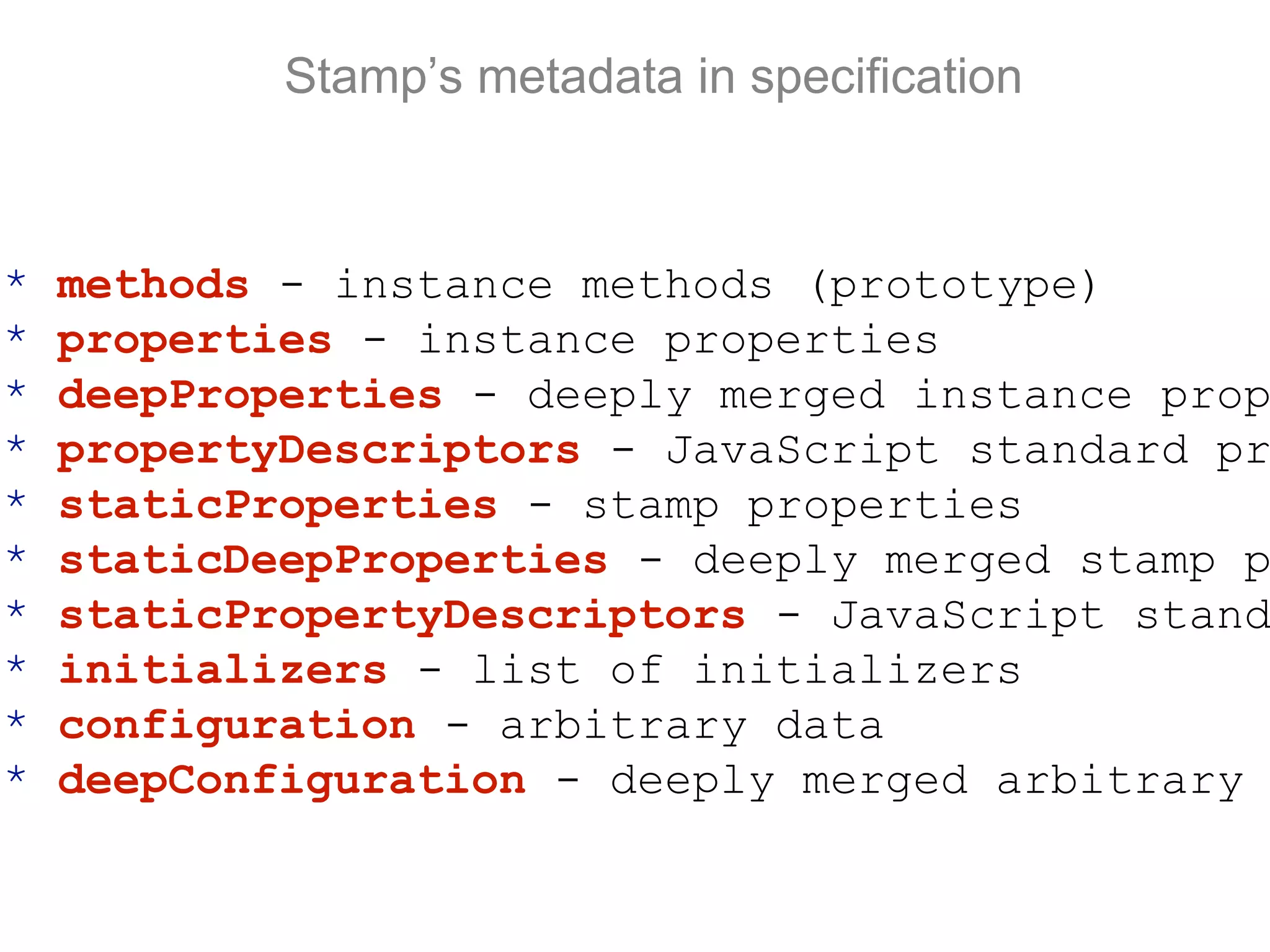
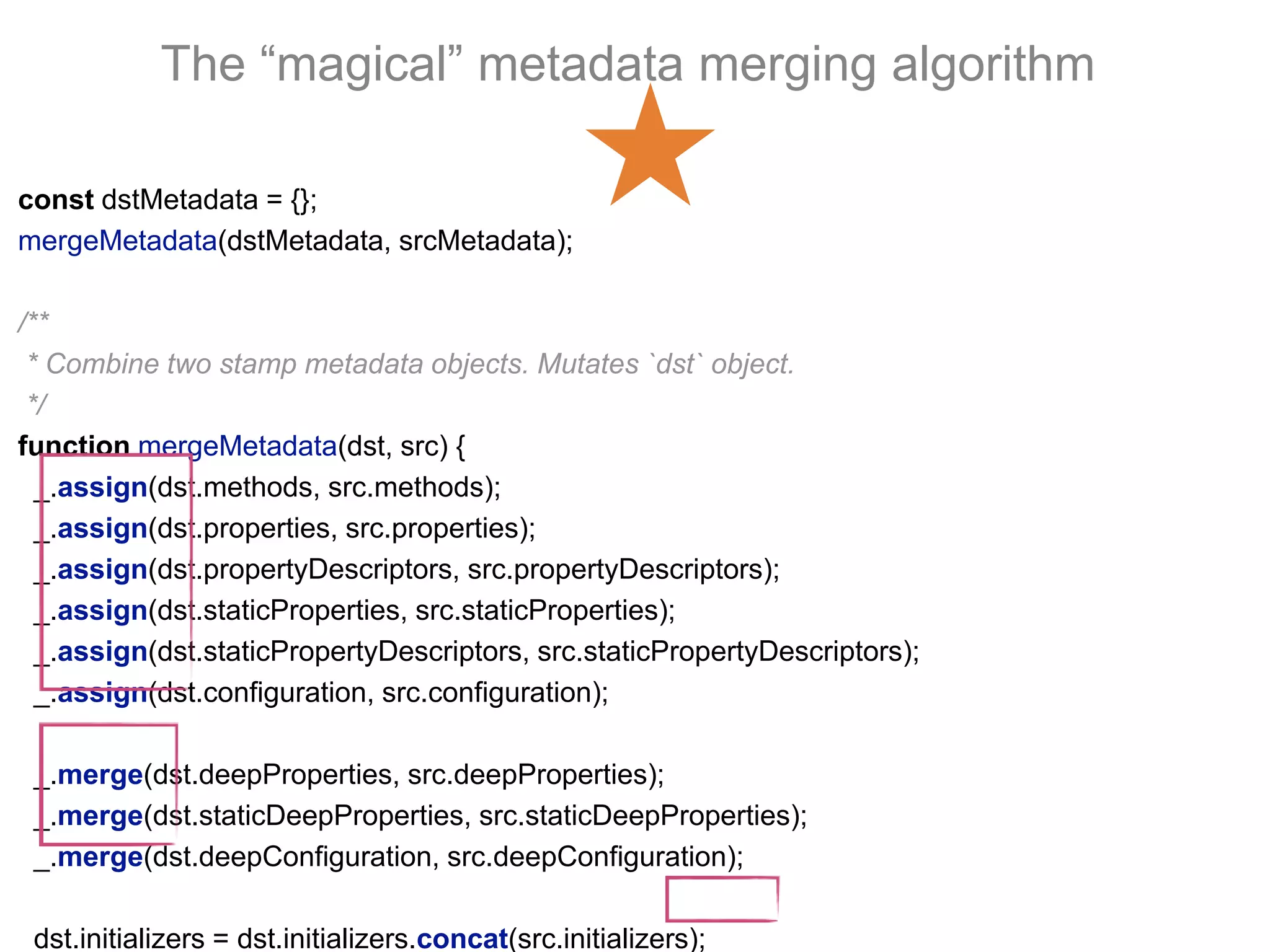

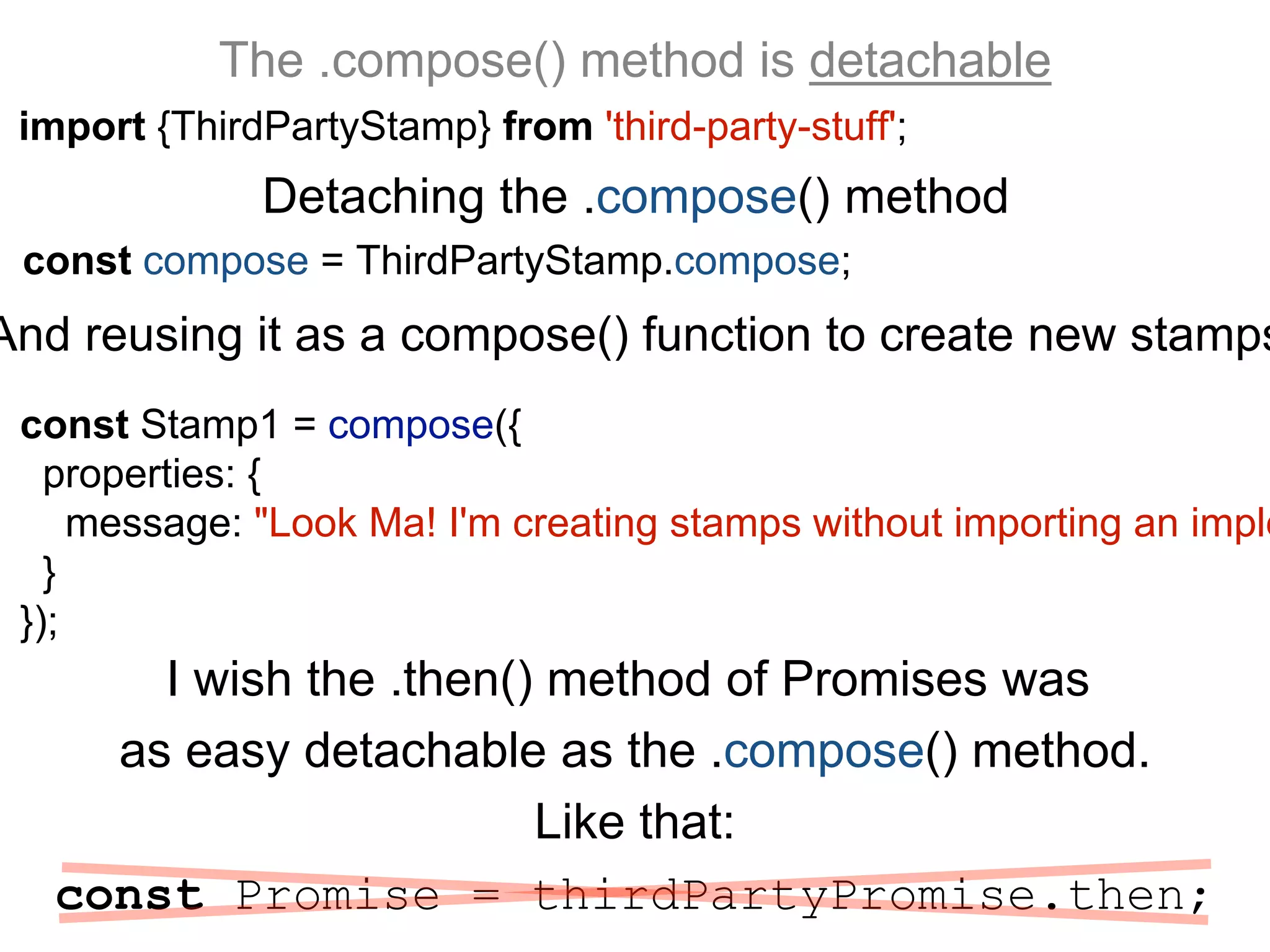
![You can override the .compose()
import compose from 'stamp-specification';
function infectedCompose(...args) {
console.log('composing the following: ', args);
args.push({staticProperties: {compose: infectedCompose}});
return compose.apply(this, args);
}
const Ctor = infectedCompose({
initializers: [function () { /* ... */ }]
});
const MethodX = infectedCompose({
methods: { X() { /* ... */ } }
});
const PropertyB = infectedCompose({
properties: { B: 42 }
});
const UsefulThing = infectedCompose({
staticProperties: { usefulThing() { /* ... */ } }
});
const Stamp1 = infectedCompose(Ctor, MethodX)
.compose(PropertyB.compose(UsefulThing));
console.log gets
executed 7 times
{](https://image.slidesharecdn.com/nodeninjaspreso-160707131938/75/Stamps-a-better-way-to-object-composition-31-2048.jpg)
![You can create APIs like that
const MyUser = compose({
initializers: [function ({password}) {
this.password = password;
console.log(this.password.length);
}]
});
// Cannot read property 'password' of undefined
MyUser();
// Cannot read property 'length' of null
MyUser({password: null});](https://image.slidesharecdn.com/nodeninjaspreso-160707131938/75/Stamps-a-better-way-to-object-composition-32-2048.jpg)
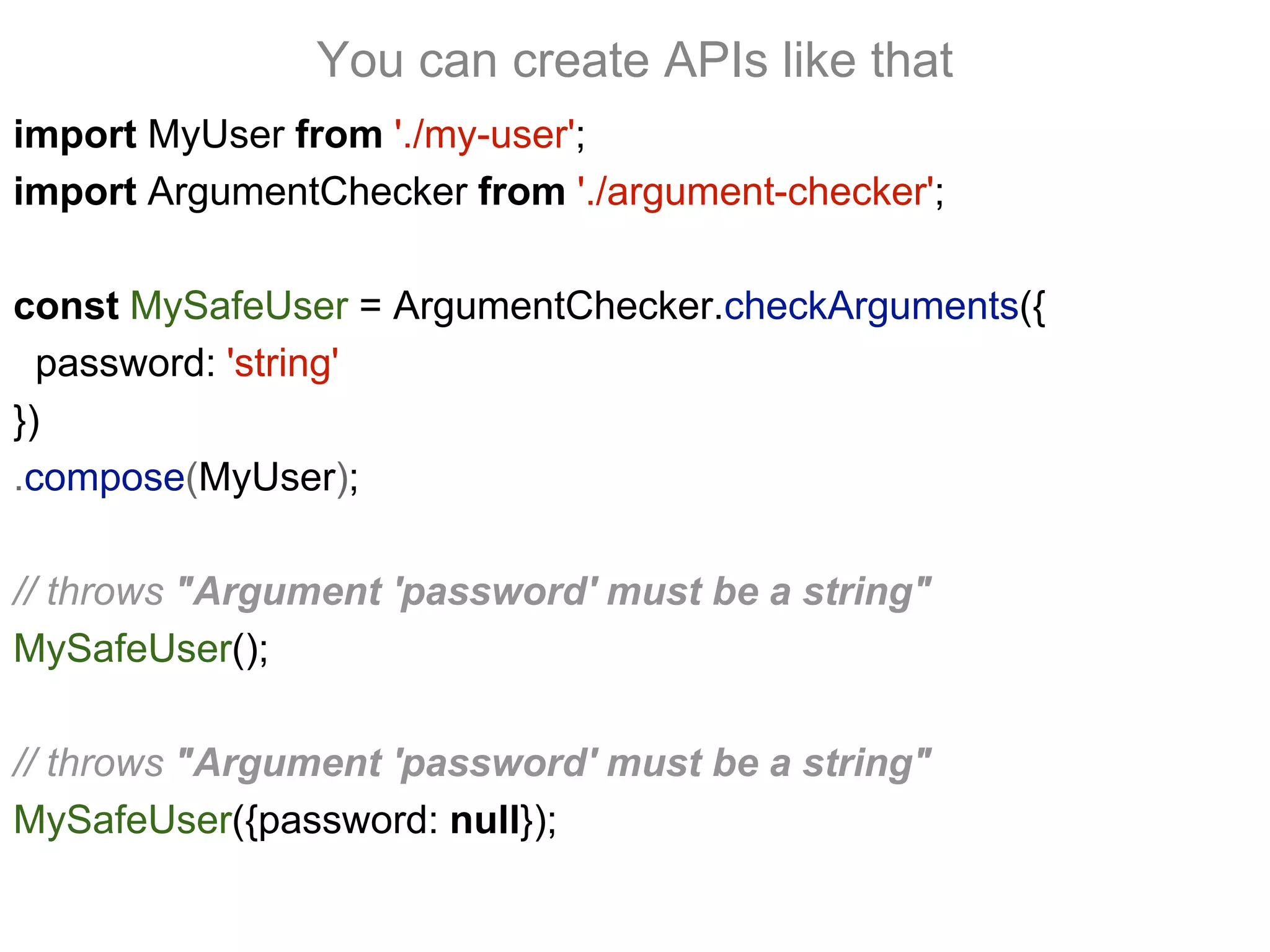
![You can create APIs like that
1 import compose from 'stamp-specification';
2
3 const MyUser = compose({
4 initializers: [function ({password}) {
5 this.password = password;
6 console.log(this.password.length);
7 }]
8 });
9
10 // Cannot read property 'password' of undefined
11 MyUser();
12
13 // Cannot read property 'length' of null
14 MyUser({password: null});
15
16
17 const MySafeUser = ArgumentChecker.checkArguments({
18 password: 'string'
19 })
20 .compose(MyUser);
21
22 // Argument 'password' must be a string
23 MySafeUser();](https://image.slidesharecdn.com/nodeninjaspreso-160707131938/75/Stamps-a-better-way-to-object-composition-34-2048.jpg)
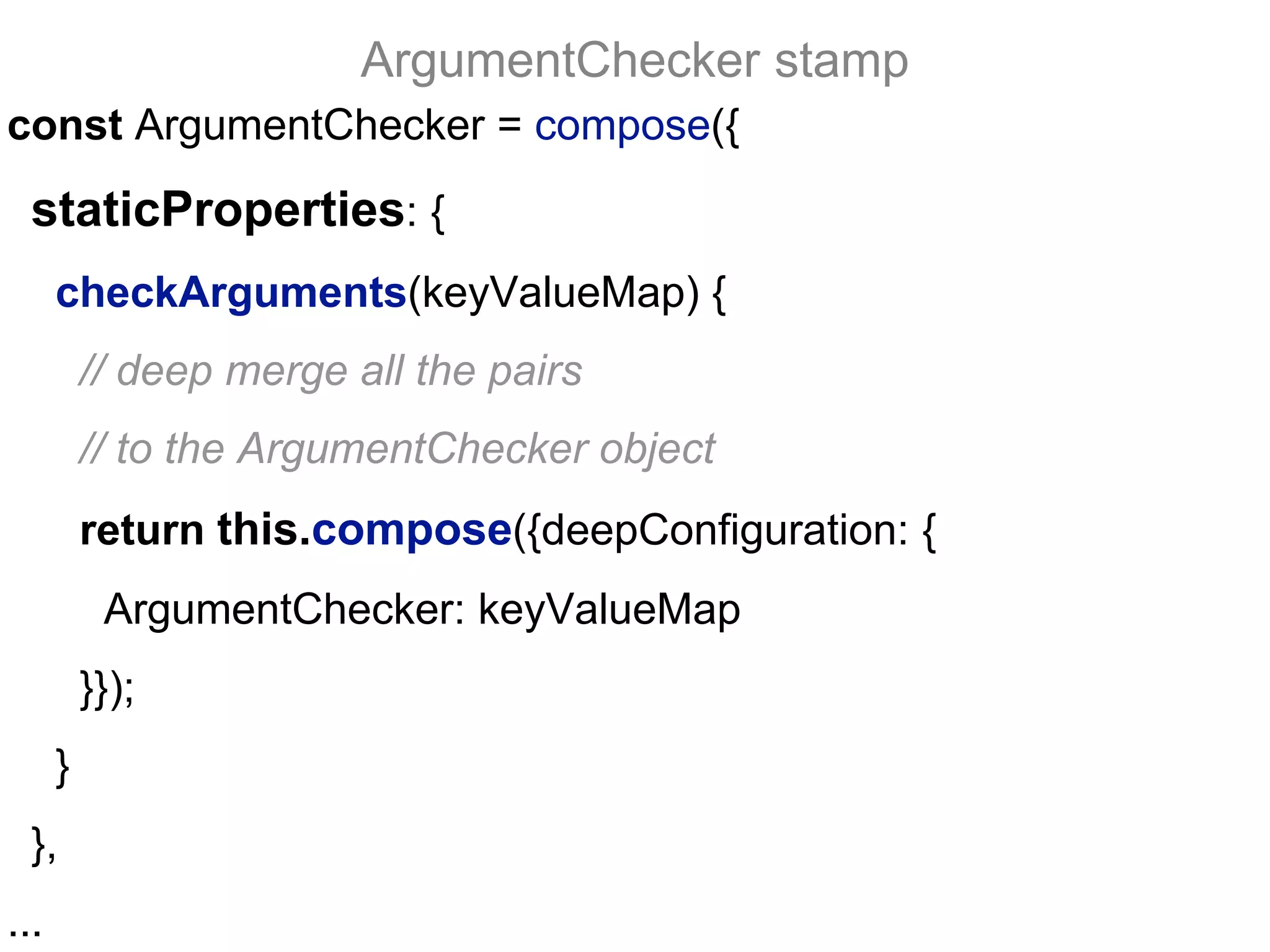
![...
initializers: [(options = {}, {stamp}) => {
// take the map of key-value pairs
// and iterate over it
const map = stamp.compose.deepConfiguration.ArgumentChec
for (const [argName, type] of map) {
if (typeof options[argName] !== type)
throw new Error(
`Argument "${argName}" must be a ${type}`);
}
}]
});](https://image.slidesharecdn.com/nodeninjaspreso-160707131938/75/Stamps-a-better-way-to-object-composition-36-2048.jpg)
![const ArgumentChecker = compose({
staticProperties: {
checkArguments(keyValueMap) {
// deep merge all the pairs to the ArgumentChecker object
return this.compose({deepConfiguration: {
ArgumentChecker: keyValueMap
}});
}
},
initializers: [function (options = {}, {stamp}) {
// take the map of key-value pairs and iterate over it
const map = stamp.compose.deepConfiguration.ArgumentChecker;
for (const [argName, type] of map) {
if (typeof options[argName] !== type)
throw new Error(
`Argument "${argName}" must be a ${type}`);
}
}]
});
ArgumentChecker stamp](https://image.slidesharecdn.com/nodeninjaspreso-160707131938/75/Stamps-a-better-way-to-object-composition-37-2048.jpg)
![ArgumentChecker stamp using stampit module
const ArgumentChecker = stampit() // <- creating a new empty stamp
.statics({
checkArguments(keyValueMap) {
return this.deepConf({ArgumentChecker: keyValueMap});
}
})
.init(function (options = {}, {stamp}) {
const map = stamp.compose.deepConfiguration.ArgumentChecker;
for (const [argName, type] of map) {
if (typeof options[argName] !== type)
throw new Error(`"${argName}" is missing`);
}
});](https://image.slidesharecdn.com/nodeninjaspreso-160707131938/75/Stamps-a-better-way-to-object-composition-38-2048.jpg)
